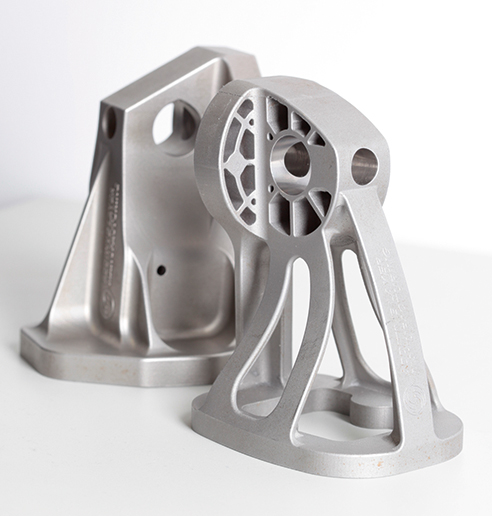EADS, EOS Pair for AM Sustainability Study

Prototype of a topology optimised Airbus A380 bracket made of stainless steel powder produced via DMLS with conventional bracket behind. Courtesy of EOS.
Latest News
February 5, 2014
Regardless of how promising a new technology appears, most companies are going to want to test its capabilities before deciding to invest. The volume of research data increases every time another company decides to look at the technology, until eventually the technology is deemed right for the job at hand.
Perhaps taking their cue from companies like GE Aviation or Rolls Royce, EADS has paired with EOS to test the sustainability of parts made using additive manufacturing (AM). The results of that study were recently made public with the publication of a case study that pits direct metal laser sintering (DMLS) against rapid investment casting.

The challenge centered on the redesign of Airbus A320 nacelle hinge brackets, with the intent of designing and building a part that was lighter and less expensive to produce. The first stage measured energy consumption of cast steel brackets against 3D printed titanium brackets over the life of the part.
As most parts make up their value in use, rather than in storage, it was determined the lighter titanium part reduced lifetime energy consumption by around 40%, regardless of the fact it actually took more energy to build the part through DMLS rather than casting.
The next step of the study evaluated the amount of material waste associated with building the brackets. No matter how careful the process, casting always results in a fair amount of waste. 3D printing is generally more efficient because AM only uses up the materials that form a finished object; waste is minimalized. EADS and EOS found material savings of up to 75% when parts were built using AM.
With figures in hand, EADS went on to make some predictions about what AM-built parts could do for its planes. The company expects it can reduce the weight of a plane by 10 kg (22 lbs.), reduce CO2 emissions by up to 40% over the lifetime of a part, and reduce material waste by 25%.
“We see several advantages in the use of DMLS, mainly concerning freedom of design and ecological aspects. We can optimize structures and integrate dedicated functionality and DMLS can significantly reduce sites’ CO2 footprints as our study with EOS demonstrated,” said Jon Meyer, ALM research team leader at EADS Innovation Works. “Considering ecology and design taken together, optimized structures can also result in reduced CO2 emissions due to weight reduction. I see tremendous potential in DMLS technology for future aircraft generations, when it comes to both development and manufacturing.”
Below you’ll find a video for EOS’ newest AM system, the M 400.
Source: EOS
Subscribe to our FREE magazine, FREE email newsletters or both!
Latest News
About the Author
John NewmanJohn Newman is a Digital Engineering contributor who focuses on 3D printing. Contact him via [email protected] and read his posts on Rapid Ready Technology.
Follow DE





